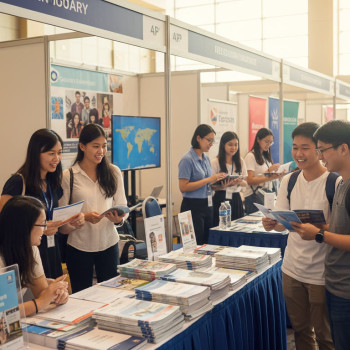Introduction: Why the SAT Still Matters for UNSW Applicants
When families start mapping out the path to a top international university, questions multiply: Do I need the SAT? Which score will make my application competitive? How does the Digital SAT change the game? For many students outside Australia, the SAT remains a valuable way to demonstrate academic readiness and to strengthen an application to the University of New South Wales (UNSW). This guide brings clarity—walking students and parents through what to aim for, how to prepare, and how to present your SAT performance alongside your whole academic story.

Understanding UNSW’s Testing Expectations
UNSW is a competitive university with high academic standards. Admissions committees look at your whole profile—high school grades, subject prerequisites, personal statements, portfolios (for some programs), and test scores when submitted. For many international applicants, the SAT is an accessible way to provide a standardized anchor to the application, especially where grading systems differ across countries.
Is the SAT required for UNSW?
The short answer: the requirement depends on the program and the applicant’s background. Some UNSW programs and pathways expect or accept standardized test scores from international applicants as part of equivalency or scholarship considerations. For many applicants from non-Australian curricula (for example, U.S. or other international systems), submitting a strong SAT score can help clarify academic readiness. Always check the specific program page and admissions conditions for the most up-to-date policy for the year you are applying.
Digital SAT vs. Paper SAT: What to know
The SAT transitioned to a fully digital format in recent years. The content still measures similar skills—reading, writing, and math—but the delivery, timing, and adaptive format differ. For UNSW applicants, admissions teams receive official SAT score reports regardless of format, so what matters most is the score and what it signals about your academic capabilities.
What a Competitive SAT Application to UNSW Looks Like
There’s no single magic number that guarantees admission. However, understanding the typical score ranges of competitive applicants helps you set realistic targets and shape a practical study plan.
How to set your target SAT score
Think of target scores as three tiers:
- Baseline: The minimum percentile that indicates readiness—this helps meet any equivalency requirements.
- Competitive: The score range that aligns with typical successful applicants to selective programs.
- Stretch: A score that makes you stand out for scholarships or highly competitive faculties (like Engineering or Commerce).
Using these tiers, set a target that’s ambitious but realistic given your schedule. If you’re balancing IB/A‑levels/APs or heavy extracurriculars, a steady, measured upward trajectory is more sustainable than a crash course.
Example target ranges (illustrative)
| Applicant Profile | Baseline Target | Competitive Target | Stretch Target |
|---|---|---|---|
| International student from non-Australian curriculum | 1100–1200 | 1250–1400 | 1450–1550+ |
| Student with strong school grades (aiming for merit scholarships) | 1200–1300 | 1350–1450 | 1500–1560+ |
| Applicant to highly competitive faculties (Engineering/Computer Science) | 1250–1350 | 1400–1500 | 1520–1560+ |
Note: these ranges are illustrative—UNSW evaluates applicants holistically. Strong academic records and relevant subject prerequisites can complement a slightly lower SAT score; conversely, an exceptional SAT can strengthen an application where grades are unfamiliar to the admissions officers.
How UNSW Uses SAT Scores in Admissions and Scholarships
For many international applications, SAT scores can serve multiple purposes:
- As a measure of equivalence when applicants come from unfamiliar grading systems.
- To support scholarship applications where a standardized metric is helpful.
- To strengthen borderline applications by demonstrating strong academic potential.
Admissions teams consider SAT results alongside course prerequisites, predicted grades, personal statements, and extracurricular depth. High SAT scores may also qualify students for merit-based scholarships or fast-track certain conditional offers—especially when paired with excellent academic records.
Practical tip for parents and students
If you’re unsure whether to submit SAT scores, consider whether the score accentuates your strengths. If your SAT is higher than your school’s converted GPA or if your educational system is not well-known in Australia, submitting the score can help contextualize your academic readiness.
Preparing for the Digital SAT: A Realistic Study Roadmap
Preparing for the Digital SAT is partly about content and partly about adapting to the test format. A well-structured plan, steady practice, and targeted feedback are the keys. Below is a practical 12-week roadmap that balances content review, practice testing, and skill-building sessions.
12-Week SAT Roadmap (sample)
| Weeks | Focus | Daily Time |
|---|---|---|
| 1–2 | Diagnostic test, goal setting, and fundamentals review | 1–1.5 hours |
| 3–6 | Content blocks: Math foundations, algebra, data analysis; Reading strategies and evidence-based reading | 1.5–2 hours |
| 7–9 | Intensive practice: full digital practice sections, pacing drills | 2–2.5 hours |
| 10–11 | Targeted weak-spot correction and timed practice tests | 2–3 hours |
| 12 | Final review, test-day routines, rest and light review | 1–1.5 hours |
Key study components
- Diagnostic testing: Begin with a full official practice Digital SAT to identify strengths and weaknesses.
- Deliberate practice: Focus on specific question types rather than just doing more tests.
- Timed practice: The digital platform’s pacing and question-adaptive blocks require specific timing strategies.
- Review and correction: Spend time analyzing errors—understanding why an answer is wrong is where real learning happens.
- Mock test conditions: Simulate test-day conditions—use the digital interface, follow breaks, and practice with the allowed calculator and tools.
How to Present SAT Scores on Your UNSW Application
When you submit an application, clarity and honesty matter. If you send SAT scores, ensure the official report is delivered by the testing agency per UNSW’s instructions for international documents. Include context where helpful—if your score improved dramatically between tests, mention the upward trajectory in your personal statement or an additional statement. If English is not your first language and you have strong SAT Evidence-Based Reading & Writing (ERW) scores, use that to bolster your application’s language-readiness narrative.
When to report multiple scores
UNSW reads your application holistically. If you’ve taken the SAT more than once, present the score profile that best reflects your abilities. Many students use superscoring strategies or send their highest section scores—confirm UNSW’s current policy on how they evaluate multiple sittings. If unsure, reach out to admissions for clarity or include a short note describing which score you’d like them to prioritize.
Sample Application Timeline: Junior Year to Final Submission
Planning ahead reduces stress. Here’s a sample timeline that maps a typical international student’s milestones from junior year through application submission.
| When | What to do |
|---|---|
| 12–18 months before application | Research programs, review UNSW entry requirements, plan SAT testing windows, schedule subject prerequisites. |
| 9–12 months before | Take a diagnostic Digital SAT, start a structured study plan, and consider booking a tutor for targeted help. |
| 6–9 months before | Take a first official SAT. Gather teacher recommendations and prepare portfolios if required. |
| 3–6 months before | Revise and retake SAT if needed. Finalize personal statement and program-specific essays. Confirm scholarship deadlines. |
| Application opening | Submit application with official SAT score reports and required documents. Follow up on any outstanding items. |
Common Pitfalls and How to Avoid Them
A thoughtful approach avoids last-minute surprises. Here are common traps and practical fixes:
- Assuming one test covers everything: The SAT is powerful, but UNSW also weighs subject prerequisites and school performance. Align your preparation to both standardized tests and subject excellence.
- Late reporting of official scores: Plan test dates so official reports arrive before application deadlines—some scholarship processes have earlier cutoffs.
- Not adapting to the digital format: The new Digital SAT has a different feel—practice on digital platforms, not just paper.
- Overlooking scholarship criteria: Merit scholarships often use a combination of grades and standardized metrics. Know those benchmarks early.
How Personalized Tutoring Can Transform Your SAT Prep
Not all study plans are created equal. Personalized 1-on-1 tutoring can accelerate progress by focusing on your unique patterns—weaknesses, timing issues, and question preferences. For many students applying to UNSW, a tailored approach is the difference between a safe score and a scholarship-worthy score.
What effective tutoring does for you
- Designs a tailored study plan aligned to your school schedule and test dates.
- Provides targeted instruction on concept gaps instead of one-size-fits-all lessons.
- Offers regular practice tests with quality feedback on both content and digital test strategy.
- Builds test-day routines and stress-management techniques.
Services such as Sparkl’s personalized tutoring combine expert tutors, 1‑on‑1 guidance, and AI-driven insights to track progress and refine your study plan. For many families, this feels like having a personal coach who understands both the SAT and the context of applying to international universities like UNSW.
Balancing SAT Prep with Schoolwork and Well‑Being
Students aiming for top universities often juggle heavy academic loads. The key is balance: steady, focused practice for the SAT while maintaining school performance and mental health.
Simple rules to keep stress manageable
- Build short, consistent study sessions—30–60 minutes of focused work beats marathon sessions.
- Schedule weekly full-length practice on the digital interface so pacing becomes natural.
- Keep weekends for restorative activities—sleep, exercise, social time. Burnout erodes returns on every hour studied.
- Use targeted help early—tutoring can prevent inefficient study habits and accelerate progress.
Putting It All Together: A Case Study
Meet Aisha (a composite example). She’s an international student in Grade 11 with strong school grades in a curriculum unfamiliar to UNSW admissions. Her school uses internal exams that don’t map easily to Australian tertiary prerequisites.
- Diagnostic SAT (Digital): 1180 (Math 590, ERW 590)
- Goal: Competitive application to UNSW Commerce with scholarship consideration—target 1400+
- Plan implemented: 12-week program, 1.5–2 hours/day, two full practice tests per month, weekly 1‑on‑1 tutoring focusing on math problem solving and evidence-based reading strategies.
- Outcome: After targeted practice and strategy work, Aisha scores 1470 (Math 760, ERW 710), strengthens her application narrative about quantitative readiness, and applies for merit scholarships with confidence.
This example shows how strategic, personalized preparation—blended with consistent school performance—can meaningfully shift outcomes.
Practical Checklist Before You Submit
Use this quick checklist to make sure your SAT-related items are covered in your UNSW application:
- Confirm whether your program requires or recommends SAT scores for international applicants.
- Schedule test dates early enough so official reports arrive well before the application and scholarship deadlines.
- Decide which SAT score(s) to report—send the one that best supports your application narrative.
- Prepare a brief contextual note if your academic system is unfamiliar or if there’s an unusual test history to explain.
- Include strong subject prerequisites and any portfolios or supplementary materials required by the faculty.
Final Thoughts: Strategy, Confidence, and the Big Picture
Applying to UNSW as an international student is an exciting journey. The SAT can be a powerful ally—especially when harnessed strategically. Aim for steady progress, use official digital practice, and think holistically: admissions officers want to see not just test scores but intellectual curiosity, resilience, and fit with the program.
If you or your student would benefit from personalized, focused support, consider options that combine expert tutors, 1‑on‑1 guidance, and data-driven planning. Programs that offer tailored study plans and clear progress tracking can make your preparation time far more efficient—helping you arrive at the test confident and ready to perform.

Where to Go Next
Start by checking the specific entry requirements for your chosen UNSW program, plan test dates so official scores arrive on time, and build a balanced, evidence-based study plan. If tailored support would help, look for tutors who understand both the Digital SAT format and international admissions—someone who can turn practice into progress.
Parting encouragement
Remember: a single test does not define you. It’s one piece of a broader academic story. With careful preparation, targeted feedback, and steadiness, you can present your strongest possible application to UNSW. Take it step by step—your best results come from consistent effort, smart strategies, and the confidence that you’re ready.
Prepared with practical insights to guide students and parents through the SAT and UNSW admissions journey.


















No Comments
Leave a comment Cancel